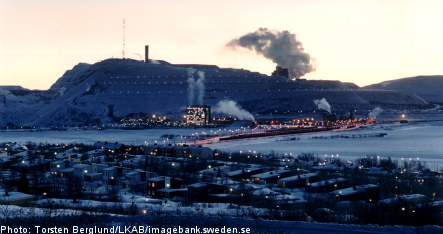Sweden’s northernmost town has long known it must relocate or sink into cracks shooting toward its centre from a century-old iron mine, but how to move an entire town, and its soul, is proving complicated.
“There are of course tonnes of technical issues: the railroad, the interstate highway, the electricity grid and water pipes and houses that all need to be moved,” said Christer Vinsa, the project leader for Kiruna’s “city transformation”.
“But the biggest challenge lies in planning the move in a way that keeps Kiruna’s soul intact and ensures that this is still a town where people want to live,” he added.
Tucked way up in the Lapland wilderness, Kiruna — whose mine is still booming — was founded around the world’s largest known single piece of iron ore, 145 kilometres north of the Arctic Circle.
It takes pride in its magnificent red wooden church, voted Sweden’s most beautiful building, one of many colourful old wooden structures that mix strangely with characterless concrete apartment buildings along the wide, snow-swept streets.
There are few visible signs of the looming danger and the city’s gradual move about four kilometers to the northwest has been paced out until 2099.
But measurements show that parts of the centre will be uninhabitable and unusable within a few short years.
“In a worst case scenario, we won’t be able to keep working here after 2013,” said Vinsa, gesturing around his spacious office in Kiruna’s square, brick city hall with its majestic metal-laced clock tower.
A new electrical grid has been built and work on the new railway is set to begin in March, while commissions have been created to determine if a number of historical buildings — notably the red church and city hall — can or should be moved.
One of the first buildings set to be moved or demolished is the home of Hjalmar Lundbohm, the man held as Kiruna’s founding father and the first head of Sweden’s state-owned mining company LKAB, which runs the mine and is financing most of the move.
“I’m a bit worried that they may decide not to move the house. I definitely think it is worth saving. It links Kiruna to its earliest history,” said Peter Stenberg, a historian and guide at the Lundbohm house.
LKAB today employs about 10 percent of the town’s 18,000-odd inhabitants, most of whom support the company and the move.
Relocating, they feel, will keep the mine in business and keep jobs in the area.
“A lot of people here depend on the mine. Before the mine there was nothing here, so most people see the move as necessary, even positive,” said Ann-Marie Mäki, 27, who lives in one of the first apartment buildings scheduled for demolition.
“It will allow us to modernize and create lots of jobs here,” said Stenberg.
The town’s inhabitants always understood the move would come one day, LKAB spokesman Anders Lindberg told AFP.
The mine shafts are not yet under Kiruna but are expected to be tunneling there soon.
“We have always known that the iron ore mass tilted towards the town,” said Lindberg, wearing a yellow hard-hat as he stood in a wide, well-lit mine tunnel once used to carry out ore.
“But more than 100 years ago when Kiruna was being built the development of the mine was going so slowly that people here thought it might take 1,000 years before it affected the town,” he says, nodding towards an old sledgehammer.
Today this old transport level, 540 metres below the snow-covered mountain top and more than 500 metres above where today’s mining activity is taking place, is an underground museum.
It is equipped with old and new machinery, vats of iron pellets, an old tram that took miners to work and even a small cafe. Videos and charts explain the effects of gradually extracting ore that stretches four kilometres in one direction, 100 metres in the other and delves to unknown depths, Lindberg said.
“We have drilled down to about 1,500 metres but we have no idea how deep it goes,” he said excitedly, adding that even in the current economic slowdown the mining was unlikely to grind to a halt in the foreseeable future.
This is welcome news for most town dwellers, whose only grumble is not knowing exactly when the town move will affect their homes or neighbourhood.
However indigenous Sami reindeer herders, who represent an important sector for the regional economy, are less than thrilled about new buildings and railway lines digging into their traditional herding grounds.
“I don’t care about my house in Kiruna being moved, but a number of the Sami villages will see their herding routes choked,” 30-year-old Sami reindeer herder Jåvna Allas told AFP, “so that is really not good for us.”
New construction sites are not expected to affect the reindeer routes immediately since the town will move gradually to ensure it stays united and whole.
“We don’t want to find ourselves with a half-built town in the new area and a half-empty town here,” said Vinsa.
“Our main goal is to have a living town, and that will take time to plan.”
By Nina Larson of AFP



 Please whitelist us to continue reading.
Please whitelist us to continue reading.